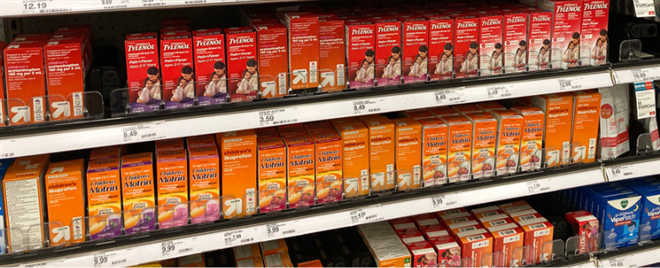Ticker Reports for April 15th
2 Under-the-Radar Consumer Staples Stocks With Big Dividends
During volatile markets, investors seek safety and defense in the consumer staples sector as necessities like food, health and hygiene products become the top priorities.
There’s also a psychological element at play: consumers gravitate toward familiar household brands they’ve trusted for years. In unstable times—whether due to weather, tariffs, or geopolitical tension—stability becomes a form of comfort.
Let's take a look at two lesser-known consumer staples stocks that have the inherent stability essential for an income portfolio. Although the company names may not be familiar, their portfolio of iconic brands will be.
Edgewell: Known Products, Underrated Stock
Schick razors, Edge shaving cream, Stayfree and Playtex tampons, and Banana Boat and Hawaiian Tropic sunscreens are a few of the name-brand products in Edgewell Personal Care Co.'s (NYSE: EPC) portfolio of household goods. The company primarily produces products in three categories: wet shave, feminine care, and sun and skin care.
While their brand portfolio is well known, they also have a thriving private label business creating custom, high-quality products for a wide range of retailers in brick-and-mortar stores and direct-to-consumer (DTC) businesses. Edgewell has over 2,000 global patents and 91% distribution of the top 50 global private-label shave retailers.
Q1 2025 Earnings Report: Weak Results in a Strong Market
Edgewell’s domestic business was soft during a strong market heading into 2025.
The company recently reported fiscal Q1 2025 (or the period ending in calendar year December 31, 2024), including an earnings per share (EPS) of seven cents, which missed consensus analyst estimates by five cents.
Revenues fell 2.1% year-over-year (YOY) to $478.4 million, falling short of $480.11 million consensus estimates.
While organic net sales fell 1.3%, international market sales rose 2% YOY, driven by price and volume gains in Wet Shave and Sun and Skincare. Gross margin fell 30 basis points to 40.1%, including 140 basis points of negative foreign currency.
Adjusted earnings-before-interest-taxes-depreciation-and-amortization (EBITDA) was $45.9 million, inclusive of $11.2 million in unfavorable currency impact.
Dollar Drop = Revenue Rebound
Edgewell’s 2025 guidance, issued in early February, cited a strong U.S. dollar as a headwind. But since then, the dollar—as tracked by the Invesco DB US Dollar Bullish Fund ETF (NYSEARCA: UUP)—is down nearly 7%.
That’s a big deal: 20% of Edgewell’s revenue comes from international sales. A 10% drop in the dollar could add $40–$50 million to annual revenue. With full-year EPS forecast between $3.15 and $3.35 (midpoint $3.25 vs. $3.18 consensus), there’s now clear upside.
A weaker dollar increases the USD value of foreign sales, making U.S. goods cheaper for international customers, which can increase demand. It can also offset some of the tariff impacts. While revenues declined in the United States, the company saw a 2% growth in foreign sales.
Even better, the stock pays a 2.01% dividend yield, making it a compelling income play.
Kenvue: Quiet Giant with Big Brands
If Edgewell is low-key, Kenvue Inc. (NYSE: KVUE) is hiding in plain sight.
Spun off from Johnson & Johnson (NYSE: JNJ) in 2023, Kenvue is the powerhouse behind Tylenol, Motrin, Listerine, Band-Aid, Neutrogena, and Aveeno. These are category leaders, not just in sales but in trust. Tylenol is the #1 pain reliever recommended by doctors; Band-Aid is the #1 adhesive bandage brand.
Q4 2024 Earnings Report: FX Headwinds, But Just for Now
Kenvue released its most recent earnings report on February 6, 2025, noting a strong U.S. dollar impacted it. Like Edgewell, foreign currency dragged results, and guidance for 2025 factored in continued dollar strength.
The company reported Q4 EPS of 26 cents, which was in line with consensus estimates. Revenues fell 0.1% YOY to $3.55 billion, falling short of the $3.76 billion consensus estimates. Gross profit margin grew 80 basis points to 56.5%. Organic sales rose 1.7% YOY, led by 2.9% growth in Self Care (Tylenol, Motrin, Zyrtec) and 2.6% growth in Skin Health & Beauty (Neutrogena, Aveeno), while Essential Health (Band-Aid, Listerine) saw a decline of 0.7%.
Is Guidance Too Conservative?
Kenvue CEO Thibaut Mongon attributed the softer sales and subsequent guidance to forex headwinds and less demand in Essential Health.
“We're entering 2025 with a challenging external environment, economic uncertainty, geopolitical tensions, and a stronger dollar. In parallel, consumers continue to look for convenience and value but are not compromising on their health," Mongon said.
With 20% of its sales from international markets, Kenvue benefits from a weaker dollar. Since guidance was issued, the U.S. dollar has dropped 7%, potentially flipping FX headwinds into tailwinds.
Kenvue expects 2025 organic sales to grow 2% to 4%, with a 3% headwind from foreign currency translation. The company also anticipates YOY adjusted operating income margin improvement and an adjusted diluted EPS growth of flat to 2% YOY, which includes a mid-single-digit unfavorable impact from foreign currency. The outlook doesn’t include any tariff impacts.
The dollar drop could soften that drag—or even reverse it. Kenvue also sweetens the deal with a 3.71% dividend yield.
Bonus Catalyst: Activists Are Circling Kenvue
Kenvue is still in the process of fully separating from J&J (expected in 2H 2025), but the sharks are already circling. TOMS Capital Management has built a stake and is pushing for a breakup. Starboard Value recently ended a proxy fight with a win, adding three directors to the board—including CEO Jeff Smith.
The result? Kenvue may become a breakup or acquisition story, offering a second catalyst beyond FX shifts and organic growth.
The Trump Dump is starting; Get out of stocks now?
The first 365 days of the Trump presidency…
Will be the best time to get rich in American history.
3 Safe Stocks to Keep During Tariff Uncertainty
There’s no hiding the fact that the S&P 500 index has been on a wild ride for the past couple of weeks. Volatility has popped with President Trump's rollout of new trade tariffs on most countries doing business with the United States. Since the stock market reflects future GDP expectations, and tariffs certainly create difficulty in forecasting future GDP, it makes sense to expect further volatility in the coming months and quarters.
That being said, there are still fundamental arguments to be made for safety in the stock market, as long as this safety comes in the form of price action driven by underlying business models. These business models should be focused on predictable and stable cash flows so that investors can have a chance of not only keeping their potential investments safe but also compounding their wealth once the uncertainty is removed from the equation.
This is where today’s list of safe and predictable businesses comes into play, as their business models allow for stability in both the company's valuations and the price action in the underlying stock. Fitting the descriptions laid out in what’s needed under today’s environment, considering T-Mobile US Inc. (NASDAQ: TMUS), Spotify Technology (NYSE: SPOT), and even Netflix Inc. (NASDAQ: NFLX) can be a great addition to portfolios today.
A Premium Offer With T-Mobile Stock
There’s always a good reason for the broader stock market to pay a premium for certain stocks, and in the case of T-Mobile, that reason is clear as day. By trading at a price-to-book (P/B) ratio of up to 4.8x today, T-Mobile commands a steep premium to the communication sector’s 1.8x average valuation.
While some value investors may call this expensive and skewed in downside potential, seasoned operators will remind them that this means a broader expectation of outperformance from T-Mobile. Fundamentally, it makes sense, considering users are never usually late paying their phone bills.
This stability in being a necessary service for the entire American population is a plus, as is the fact that this is a subscription-based business. This adds a layer of predictability in cash flows every single month for management to efficiently manage and redeploy further into compounding value.
Understanding the importance of these predictable and stable cash flows, as well as the fact that T-Mobile has very little downside exposure in terms of tariffs and trade, institutional investors from GAMMA Investing decided to initiate a stake of up to $814.4 million in T-Mobile stock as of April 2024, a clear sign of confidence moving forward.
More Optimism in Spotify During Volatile Markets
Spotify is another business that displays the strong stability and predictability of a subscription-based model. In the days before the trade tariffs announcement, some Wall Street analysts became even more aggressive with their upside forecasts.
In fact, those from Wells Fargo decided to reiterate their Overweight rating on Spotify stock as of late March 2025, this time also placing a valuation target of up to $740 per share. This new view would call for the stock to make a new 52-week high and implies a net upside potential of 34% from where it trades today.
Of course, realizing this target would require more momentum buyers to come into the scene and support the stock, so at this point, it sort of becomes a self-fulfilling prophecy that investors could get behind in the coming months and quarters. The bull case for Spotify seems strong and obvious not only to these analysts but also to the same buyers who recognized the T-Mobile opportunity.
As of April 2025, allocators from GAMMA Investing added Spotify to their buying list, placing up to $394.8 million into the company to start the new quarter and another bullish pillar for investors to lean on.
An Undeniable Driver Behind Netflix Stock
Netflix is another service that probably ranks last on the list of expenses to cut during tough economic periods. After all, its users see little to no churn once they become subscribers and streamers. Needless to say, the economic uncertainty does add a bit of extra appeal to having Netflix over a more expensive plan to visit the theatre.
With this in mind, as consumer themes seem to tighten over discretionary spending, Wall Street analysts see up to $6.28 in earnings per share (EPS) for the third quarter of 2025, a significant boost of as much as 49.5% from today’s reported $4.20 in EPS.
As every investor knows, where EPS goes, so does the stock price. In the case of Netflix, which now sits at 86% of its 52-week high level, everyone can see that this subscription business has significantly outperformed the broader S&P 500 index in one of its worst weeks in financial history.
Warning: "DOGE Collapse" imminent
Elon Strikes Back
You may already sense that the tide is turning against Elon Musk and DOGE. Just this week, President Trump promised to buy a Tesla to help support Musk in the face of a boycott against his company. But according to one research group, with connections to the Pentagon and the U.S. government, Elon's preparing to strike back in a much bigger way in the days ahead.
3 ETFs Thriving in April's Market Chaos—Are You Missing Out?
With markets see-sawing up and down on a daily (or even minute-by-minute) basis on hints of global tariffs updates, there's an opportunity to time an investment to win short-term gains.
However, most investors are likely looking for a safer bet—an investment that is likely to appreciate over time or at least one that is relatively unaffected by the downturn.
Exchange-traded funds (ETFs) present a compelling option in this climate. By design, ETFs spread exposure across multiple assets, providing diversification that can help cushion against sudden market downturns. Though not immune to volatility, several ETFs have outperformed the S&P 500 in both the five-day and one-month periods ending April 11, 2025.
ProShares DJ Brookfield Global Infrastructure ETF (NYSEARCA: TOLZ), ProShares VIX Short-Term Futures ETF (BATS: VIXY), and KraneShares MSCI All China Health Care Index ETF (NYSEARCA: KURE) are three standout performers that investors may want to keep on their radar.
Looking for Stability? This Infrastructure ETF Delivers
First up is the ProShares DJ Brookfield Global Infrastructure ETF, a fund targeting companies around the world that focus on oil and gas, water, electricity, and other infrastructure.
Because these services and facilities are essential regardless of the state of the markets, they tend to be a more defensive play when volatility is high. The fund's breadth means that it includes companies of multiple market capitalizations and all developed markets, potentially further insulating it from the impact of tariffs on the U.S. economy in particular.
Investors may note that TOLZ has a significant focus on oil and gas infrastructure, with about 40% of the portfolio weighted to that industry. Given the sudden drop in the price of oil amid the ramping up of a trade war between the United States and China, there may be concern about the impact on this segment of the TOLZ portfolio. However, the fund's broad mandate gives it the flexibility to shift allocations toward firms with potentially greater stability.
TOLZ is up about 3.4% in the five days leading to April 11 and down under 1% in the last month. By contrast, the S&P 500 is down about 5% in the month leading to April 11.
A VIX-Focused Fund to Capitalize on Short-Term Volatility Spikes
One way to turn the recent market turbulence into a positive is through a fund like the ProShares VIX Short-Term Futures ETF.
This ETF is linked to an index of futures of the CBOE Volatility Index, commonly known as the VIX, which gauges investor expectations of volatility. As anxiety over future turbulence increases, so too does the VIX—a short-term futures fund like VIXY can thrive at times like the tariff-related uncertainty of early April.
As a short-term fund, VIXY is not designed to be held over longer periods. But it has spiked significantly in 2025, the predictable result of ongoing and increased fear about the nature and impact of tariffs from the Trump administration across market environments.
Chinese Healthcare Names Rebound Sharply From Tariff News
Another approach to identifying funds that may not be heavily impacted by U.S. market upsets is to look to those with an international focus. The KraneShares MSCI All China Health Care Index ETF (NYSEARCA: KURE) capitalizes on the massive Chinese equities market, specifically the healthcare sector—which climbed to nearly half a trillion dollars in 2023 alone—with stocks listed in mainland China and Hong Kong as well as in the United States.
A benefit for U.S. investors is that it may be relatively insulated from short-term volatility in the domestic equities space, although the building trade war between the United States and China could have a longer-term impact. On the other hand, KURE's portfolio of close to 50 names likely includes many stocks with which U.S. investors are not typically familiar, so additional research may be necessary to stay informed.
Though KURE dropped in early April in the lead-up to new tariffs, it rebounded strongly in the several days leading to April 11, reaching an overall improvement of more than 10% in the five-day period through that date.








